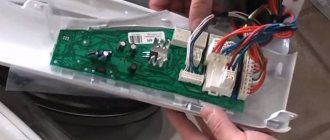Disassembly without using a grinder
In order to separate the ferrous metal from the copper, you must first disassemble the compressor. Let's figure out how to disassemble the device without using an angle grinder (grinder), because an angle grinder is a relatively dirty tool; there will be a lot of dust, sparks, noise in the workplace, oil poured inside (the cutting disc will splash materials around it).
Unfortunately, the body is a monolithic metal product containing a series of welds created using automatic welding.
Therefore, you can avoid the grinder only with a hacksaw. The thickness of the metal can be more than 3 millimeters. As for the rotor and stator, an angle grinder is not required; it should not be used at all stages of disassembly.
In the welding area you need to make a cut, drain the oil and “walk” along the entire seam.
The cut should be small to avoid splashing. Oil should flow out slowly through the small hole.
Cutting should be done carefully, without haste; If you work with a hacksaw, you should monitor the sharpness of the saw (it is better to stock up on spare blades). The motor windings are visible under the cut cap. After unpacking the case, you can discover the causes of the device malfunction. In our case, the cause is a burnt-out winding.
Purchase of a two-chamber refrigerator "Nord"
When deciding to purchase a refrigerator, you should consider the following parameters:
- Size and volume. They must meet the needs of the owners.
- Number of cameras and their specialization. Traditionally, a two-chamber refrigerator is optimal.
- Energy consumption type.
- Defrost type.
- Number of compressors.
- Design and internal structure.
- Additional functions. It must be remembered that each additional option usually leads to an increase in the cost of the unit.
- Brand. It is worth choosing manufacturers with a long and reliable history.
For all these parameters, the best choice would be a two-chamber Nord refrigerator, the price of which, by the way, is very pleasant (starts at 13-14 thousand rubles). This choice is confirmed by the consistently high sales of such devices in Russia and the CIS countries.
Compressor disassembly options
There are two ways to disassemble: knocking out and cutting the rear cap. Thin-walled models come out of the case very easily when knocked out; older models are almost impossible to knock out. If all the oil has been previously drained, you can immediately begin sawing without making test cuts. Use a hacksaw to cut off the “back cap”.
One tube will not allow the cap to come out of the body; it is enough to cut it with a hacksaw. After disassembly, you can see the entire engine from the inside.
Screws are visible, unscrewing which allows you to release the entire mechanism and remove it from the case.
Without cutting off the ends of the compressor, it is impossible to disassemble it, since all compressors are manufactured in the form of a monolithic structure. Both sides of the shell are welded, and the screws that can solve the problem are located under a layer of thick metal and welds.
After unscrewing the support bolts, the motor, gearbox, stator and rotor are revealed. To remove copper windings and cores, do not use a grinder and cut the shell from the inside. Everything is held on with screws and can be easily disassembled.
Opening the refrigerator compressor with your own hands
Object of autopsy:
The task is to preserve the flanges of the casing halves for further tightening. The difficulty is the semicircular shape of the welded joint.
At the Forum, the option of grinding the grinder with a grinding disc was proposed, but after this the dimensions of the flange will be greatly reduced. It will be more difficult to tighten. It is very difficult to cut straight through the joint - the disc will slide off the top of the roller. “Improved” my ratsukha. Persons with unstable mental health should not read further!
I made a set of “remnants”. The kind that normal “Bulgarians” throw away. Without considering myself one of those, I accumulated them... in general, a lot. Therefore, I found it easily: 2 cheeks, 2 spacers, the actual cutting one. The difficulty is that the thickness of the package is greater than what can be centered with a standard Bulgarian nut. I had to “by eye”...
I made a groove at the top of the roller along its entire length:
Next, I cut through 1mm of soap (so as not to damage the patient’s intestines) until the casing is completely halved.
All. No matter how sick my grandmother was, she still died.
By the way, after this work there are remnants left, which I will throw away without pity!
Although... You can get some good spacers... Let them sit for a while.
PS: such an opening takes much more time than in the case when you just need to remove the MK from the casing without saving the latter.
Disassembling the compressor from the refrigerator
You can disassemble the compressor using a grinder. If you cut off the top of the cap, you can see a vertically located engine and a block with one cylinder. The freon tube is bent into a spiral so that there is play in the tubes during vibration. If the tubes are tightly secured, vibration will cause them to break.
Cutting the top will do nothing to remove the engine, so you can cut off the bottom of the compressor. The bottom view gives an idea of the cooling of the entire compressor during operation. At the bottom there is a tube through which freon is circulated, cooling the engine itself. In addition to the tube, shock-absorbing fasteners on which the engine is mounted are visible on the sides. As a result of the fact that the engine converts the rotating movement of the shaft into the translational movement of the compressor piston due to the eccentric on the engine shaft, vibrations occur in the entire mechanism. To compensate for vibration on the shaft next to the eccentric, metal was selected in such a way as to level the masses during rotation, balancing the entire system. The engine is also placed on springs placed on pins. Nuts are not used. The engine is limited at the top by a cap. The motor connection connector is also located here.
The first cut went through the bottom of the cap and was useless for disassembly, just like the second cut. To remove the engine from the housing, you need to make a cut under the head or in the middle of the tank. The removed engine is covered in oil. The windings are clearly visible on it - working and starting. The starting winding is made of thick wire and has low resistance. The working winding is the exact opposite of the starting winding: small diameter and high resistance.
After removing the casing, the engine and compressor present a deplorable sight.
By removing the four screws holding the compressor housing in place, the compressor and motor can be separated. The eccentric and balance plate are visible on the engine. On the compressor you can see the piston itself with a hole for the eccentric, which pumps freon into the system.
There are only 4 chambers on the compressor. Through some, freon is taken from the system, through others, with the help of a piston, freon is compressed and pushed back into the system.
This is roughly how a refrigerator compressor works.
A single-phase electric motor has two windings connected in series with an output from a midpoint.
To start such an engine, you need to apply either phase or zero to 0 common, and either zero or phase to 1 start and 2 working, respectively. In other words, the voltage between pins 1 and 0 should be 220 V, between pins 0 and 2 - 220 V, and between pins 1 and 2 the voltage should be zero. If the voltage is applied correctly, the engine will jerk and the rotor (the part of the engine that rotates) will begin to rotate. The direction of rotation depends on which end of the working winding is connected to the common terminal. In a refrigerator, it is impossible to start the engine in the other direction, because the common terminal is located inside the hermetically sealed compressor.
After the rotor begins to rotate, you must immediately turn off the starting coil. Otherwise, the motor will overheat and the winding insulation will burn out, which will cause an interturn short circuit and damage the motor. To disconnect the starting coil, it is enough to disconnect pin 1, then the voltage between pins 0 and 2 is 220 V and the engine will not stop.
The starting coil is only needed to start the engine and is not needed at all while it is running. To accurately determine the health of the engine, use an ohmmeter; the resistance values are visible on the device.
The starting current of the refrigerator compressor motor is 4.8 A, and the operating current is 1.02 A. At the same time, the resistance of the starting winding is 13.1 Ohms and the operating winding is 47.5 Ohms. Small fluctuations of 0.5 ohms are acceptable. It should be taken into account that the more powerful the refrigerator, the higher the resistance and current values will be.
All manufacturers see their compressors differently and the starting winding is not always higher in resistance than the working winding. Many foreign manufacturers have a working winding larger than the starting winding. This difference is only a few ohms. It all depends on the manufacturer and the specific compressor. On the compressor label you can see three connection points similar to the compressor connector.
- C - COM, means the point of connection of two windings, i.e. center point
- S - START, starting starter winding
- R - RUN or M - MAIN, working winding.
For comparison, I present the resistance of the compressor windings of refrigerators from different manufacturers.
The engine is controlled by a starting relay. The relay is located in a plastic box to the right of the installation junction box.
When a single-phase electric motor is turned on, a large starting current flows through the working winding. The starting current is 3-7 times the rated current of the motor, it lasts only for a while until the motor rotor begins to rotate and reaches the rated speed. The relay coil is connected in series with the working winding of the motor, so when the current is high, a magnetic flux will appear in the coil, which will push the coil core up. At the end of the core there is a contact plate that connects the starting winding of the motor to the network. As soon as the rotor rotation speed reaches the planned value, the starting current in the working winding will drop, the magnetic flux in the starting relay coil will drop and the plate will lower, disconnecting the starting winding of the engine from the network.
If the engine overheats, that is, if the engine rotor does not have time to pick up rotation speed, or if the engine itself is faulty, an emergency shutdown of the electric motor from the network is provided. The protection is made in the form of turns of nichrome wire. Nichrome is an alloy of the metals nickel and chromium. When current is passed through it, the nichrome heats up and releases heat, but does not burn. That is why most electric heating devices contain this metal.
When large starting currents flow, nichrome heats the bimetallic plate located underneath it, the plate heats up and bends, disconnecting both motor windings from the network. After some time, the nichrome will cool down, the bimetallic plate will return to its normal position and the relay will restart the refrigerator again. If you have a refrigerator at your dacha and during a thunderstorm, or when a welding machine is working nearby, the refrigerator growls and does not turn on, then know that there is not enough voltage for the rotor to gain the required speed and the protection is triggered.
The start and shutdown of the refrigerator is controlled by a temperature sensor, which gives the start command by applying a potential to the common terminal of the motor. The temperature sensor is a sealed tube filled with gas, a housing with a rod for regulating the temperature at which it operates and leads for connecting wires.
Sometimes two sensors are installed - one on one camera, and the second on the second camera. Or the second sensor is used for the defrosting function, which means that the refrigerator will not turn on until it is completely defrosted.
When assembling and connecting all wires, you must observe the correct electrical diagram. For clarity, all wires are marked. 220 V (brown and blue) comes from the network. The compressor motor is also powered by 220 V. Power is supplied to the motor from the brown power wire through the blue wire (3). The second wire to the engine is taken from the brown network wire through the gray wire to the temperature sensor, the output from the sensor is a white wire connected to the black wire (0). To check whether the compressor is working without a temperature sensor, you need to apply a voltage of 220 V to the blue (3) and black (0) wires suitable for the start relay.
For those who are especially meticulous and don’t have a start relay, you can take three pieces of wire. Connect one to terminal (0) on the compressor plug, the second to the end of the working winding (2) and the third to the end of the starting winding (1). The free ends of the wires (1) and (2) must be connected together. It is advisable to equip the wire to terminal (1) of the compressor with a toggle switch, but it is possible without it. Now you need to apply power. Insert the wire to terminal (0) into one contact of the socket, and the wires connected together to terminals (1) and (2) into the other. Almost immediately you need to disconnect the wire to terminal (1) from the network. The relay response time is approximately 0.5 s. It’s better to disconnect it with a toggle switch, but you can also use side cutters with insulated handles. The compressor will start working. To start it again you will need to cut the wire again. There are never too many wires, so if there is no relay, assemble a switching circuit through a toggle switch or circuit breaker. The engine runs on 220 V, which is supplied to contacts (0) and (2). Just to start, you should connect to contact (1) the same wire that goes to contact (2).
Almost all single-phase motors can be started from a capacitor. The fact is that single-phase motors operate from brushes (one stator winding and one armature), starting relays (two unequal stator windings) and a capacitor (two stator windings). The capacitor is connected between the ends of both windings according to the diagram below.
On average, the capacitor capacity is taken at the rate of 22 μF per 1 kW of engine power. It turns out that a 155 W refrigerator motor needs a 3 µF capacitor. You need a paper capacitor. The supplied 160 V capacitor did not heat up or explode, but it did crack, so we are looking for a capacitor of at least 250 V. The heating of the windings will serve as an indicator of operation. The reason why a relay is used to start the refrigerator compressor is higher starting reliability. And indeed, during tests, the engine started when the power cables were switched sharply, but when started using a switch, sometimes the engine did not rotate, but hummed. This is due to the fact that a starting capacitor was not used. The starting capacitor is connected in parallel with the working capacitor and only when the engine starts. The capacity of the starting capacitor is 3 times higher than the capacity of the working capacitor.
Step-by-step instructions for repairing refrigerator components and systems
Once you have determined the cause of the problem, you can begin to eliminate it. Consider the most common options.
Troubleshooting the thermostat
Depending on the specific model, the thermostat can be located both inside the refrigerator and outside. With an internal location, it is enough to remove the temperature control knob and remove the thermostat housing.
In refrigerators from Samsung, LG and other foreign brands, you can also check the thermostat under the panel for decreasing and increasing the cooling temperature. But it is located on the outside of the chamber. To determine functionality you will need:
- Disconnect from the network;
- Defrost completely;
- Turn on the refrigerator for maximum freezing, placing a thermometer inside and wait a couple of hours; if the device does not show 5 - 7 ° C, then replacement is inevitable.
To repair a refrigerator, you just need to purchase a spare part and install a new one to replace the faulty part.
Finding leaks and replacing refrigerant
Leaks can be detected using several methods:
- Soapy solution - available in case of a slight leak and the presence of liquid refrigerant pressure in the system. This provides access to all tubes - the protective housing cover is removed and the evaporator is defrosted. Where the gas escapes, the soap solution will foam.
- Dye - used where the pressure in the circuit does not allow the use of a soap solution. A dye is added to liquid freon and released into the system, after which a characteristic color appears at the leak site.
Before pumping new gas from the system, the residues are first removed by a vacuum pump; if blockages are detected, additional cleaning is carried out. After which refueling is carried out. Experts recommend performing this procedure without leakage every 3 to 5 years.
Thermal protection relay failure
If the normal operation of the temperature fuse is disrupted, the refrigerator may shut down prematurely, which poses a risk of engine overheating. To repair, you will need to remove the relay and disassemble its body; if the reason is a jammed rod, you can solve the issue yourself; if the winding is damaged, you will have to change the entire part.
Replacing a faulty compressor
In this case, for repair it is necessary:
- Unplug the refrigerator;
- Tilt the compressor and run the compressor for a couple of minutes;
- The piercing valve is attached to the filter drier, connect the cylinder to the valve and tighten the piercing valve and open it for half a minute;
- Instead of a filling tube, solder a copper tube;
- Make a cut on the capillary tube;
- Remove the old compressor and install plugs in the suction and discharge outlets;
- Install the new compressor and solder it, carefully inspect the quality of the soldering.
Compressor repair
Eliminating rattling compressor sounds
The noise of the compressor can be caused by a loose fit of metal elements or, conversely, excessive proximity of certain elements, which causes collision and rattling.
For repairs, it is necessary to secure the casing tightly; in case of loose fasteners, use washers for a tight fit and tightening.
Figure 4. Adjusting the compressor mounting (shown by arrows)
In case of approaching other elements, it is necessary to adjust the device itself in the opposite direction or carefully bend the tubes if it is impossible to move the compressor.
Replacing lighting bulbs
To avoid electrical injury, unplug the refrigerator. Then open the door and check the condition of the lighting device, for example, in Indesit refrigerators, the light bulb can get very hot, so you should wait until it cools down completely.
To do this, it is not necessary to use the same lamp, but you can find an alternative replacement, but according to the type: incandescent or halogen. The lamp power should not exceed 30 W. But before replacing, it is worth checking the voltage in the socket, because the reason may not be in the lamp at all.
Solving problems with temperature sensors
This part is designed to regulate the speed of operation of the compressor unit. If they fail, the refrigerator will not be able to maintain the desired temperature. Quite often such a malfunction occurs in Nord refrigerators; they contain several such elements at once.
But you won’t be able to disassemble and repair them yourself at home, so after removing the sensor, it will need to be completely replaced.
Cleaning the drainage system
There are two options for placing the tube - outside the body and under it. In the first case, cleaning is quite simple: remove the tube and rinse it in hot water, loosening any accumulated clogs if possible.
If it is impossible to remove the tube, you should try to clean it with the brush included in the kit. If it fails, metal wire, previously sanded, is used for repairs. After cleaning the tube, it must be rinsed with water.
Repair of drainage tube
Door alignment
To adjust the position, you need to get to the fastening point, for example, in LG refrigerators you will need to remove the protective strip; in other models, the bolts may be in the public domain. After unscrewing, remove the door, place washers in the required nodes and install the door in place. If any, assemble the decorative structures in the reverse order.
Control board failure
It is characterized by complete silence of the refrigerator, despite the fact that the power circuit is fully operational. The control board is one of the most complex devices and one of the most expensive. Replacing it at a service center will cost three times as much, so it’s better to do the repairs yourself. For this:
- Unplug it from the outlet and unfold it; in Stinol refrigerators and many other brands the board is located in the lower left side.
This is how the control board is removed - Unscrew the fastening screws A and remove the clamp B;
- After this, you can see the board itself in the case; carefully disconnect terminals C.
Control board
Most often, capacitors deteriorate due to constant voltage surges, so to prevent such repairs in the future, it is better to connect the refrigerator through a stabilizer. The installation location may differ from company to company, so first you will have to study the refrigerator diagram.
Evaporator defect
It manifests itself in weak freezing, the appearance of a snow coat or rapid spoilage of food. Occurs due to damage or destruction of the walls of the evaporator, both from natural processes and from exposure to sharp objects.
Video: how to disassemble a compressor from a refrigerator
I recommend to read:
- Removing and Disassembling a Refrigerator Door - How to Disassemble a Refrigerator Door to Re-Hang It on the Other Side At the very top of the refrigerator, above the freezer door (you may need a ladder), remove two...
- Disposal of refrigerators - we dispose wisely! From sales to disassembly and recycling - What to do when the old model breaks down and no longer performs its functions? There are several options for solving the problem, which we will introduce you to in this article. U...
- How to move the refrigerator doors to the other side yourself - detailed step-by-step instructions - The easiest way to do this is when such manipulations are provided for by the design of the unit. In this case, technological holes are made on the door on both sides. Only…
- How to move the refrigerator door to the other side yourself: detailed step-by-step instructions - The easiest way to do this is when such manipulations are provided for by the design of the unit. In this case, technological holes are made on the door on both sides. Only…
- Instructions for making a smokehouse from a refrigerator with your own hands - Old household appliances can be used on the farm in the most unconventional way. For example, a refrigerator that has served its age is an excellent springboard for a home craftsman. One…
- How to sew a cooler bag yourself: step-by-step instructions - In the summer, a cooler bag is indispensable. But if you don’t have it at hand, and you still need to store chilled food on the road, you can sew a cooler bag with your own hands. Exists…
- Removing the refrigerator door - Step-by-step removal of the upper door of the refrigerator To complete all work, you will need operating instructions for the refrigerator from which the door will be removed...
Design of the Nord refrigerator
Each two-chamber Nord refrigerator has one compressor that pumps in cold. The heated refrigerant is supplied under pressure to the condenser, where it is converted from a gaseous state to a liquid and, when it hits the evaporator, it takes heat from the refrigerator chamber. The device has a sealed refrigeration unit. The freezer compartment in Nord refrigerators can be top or bottom mounted. The units meet all sanitary and environmental safety requirements. The refrigerator compressor accumulates pressure that is up to eight times higher than, for example, the pressure in a home water supply. The evaporator may accumulate condensation and require defrosting. Modern models are provided with forced airflow of the evaporator, which guarantees their dryness, and such refrigerators do not need defrosting.











